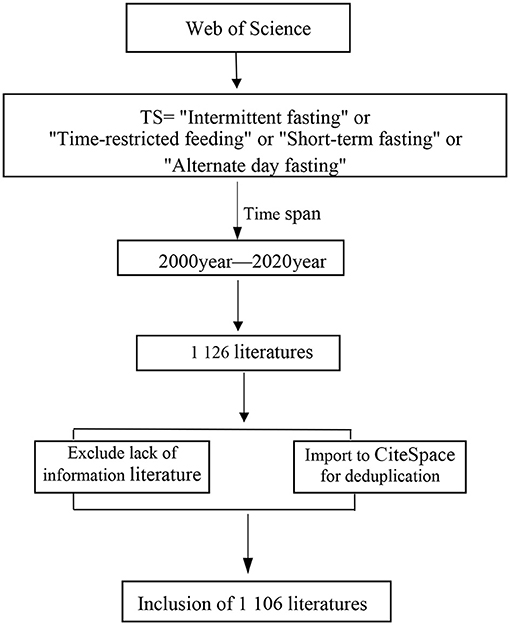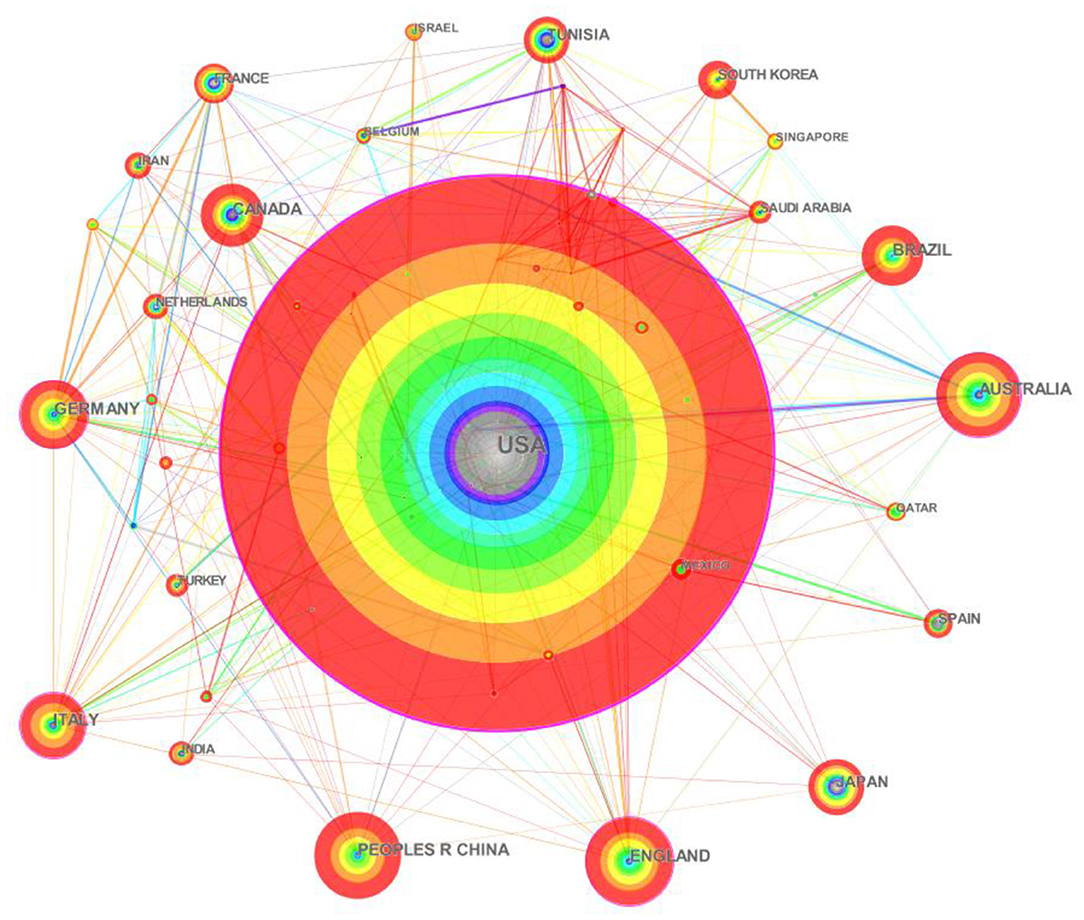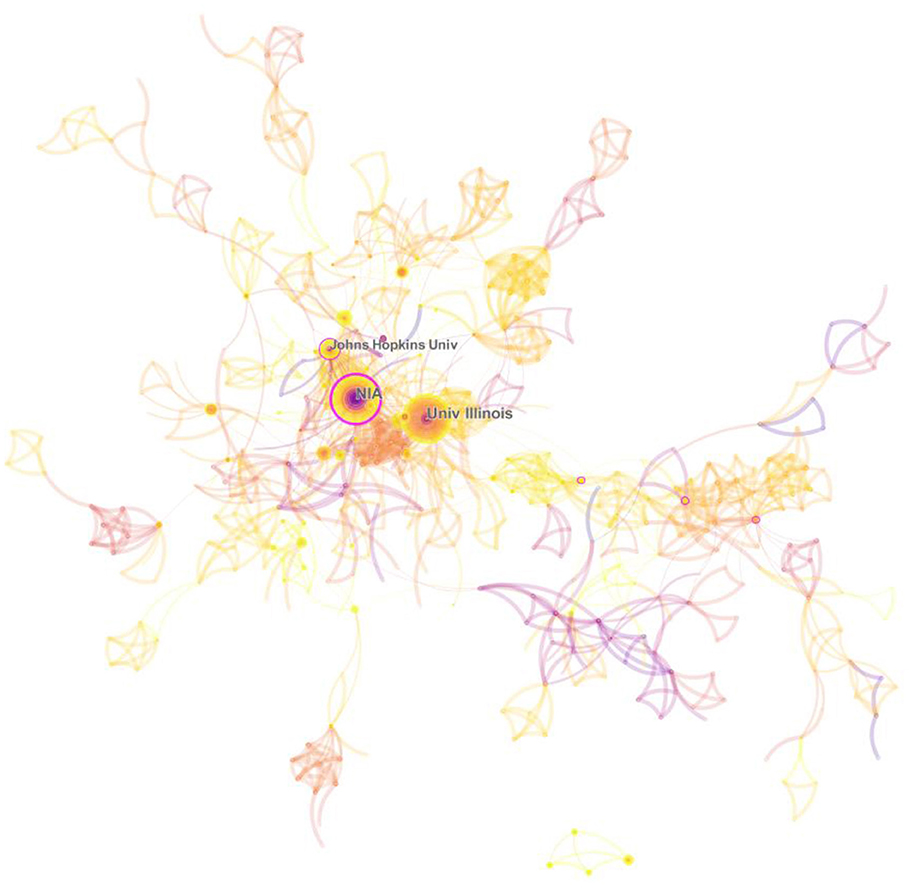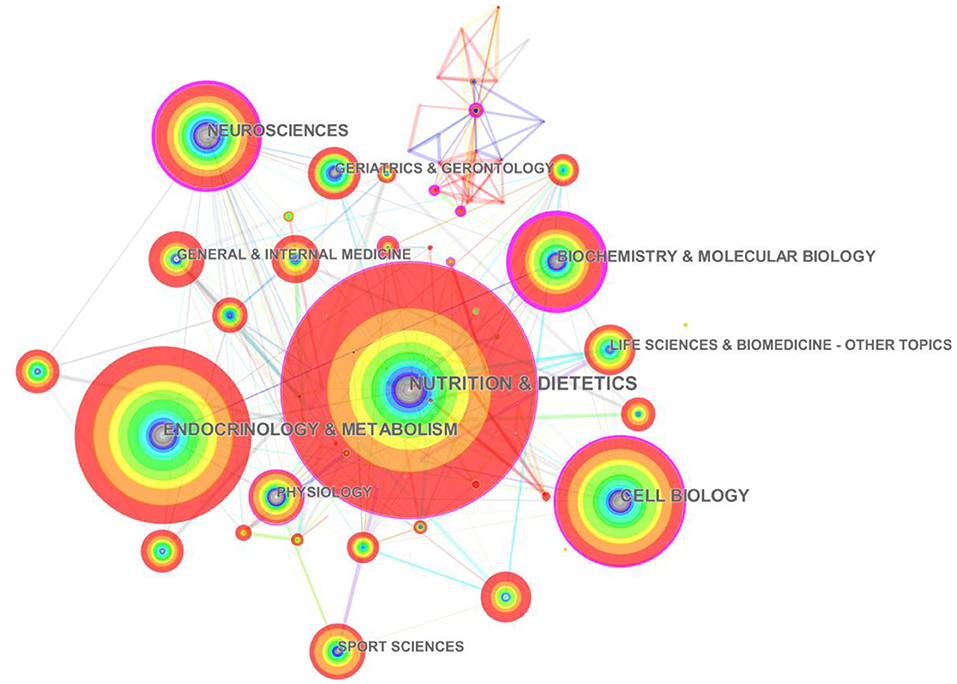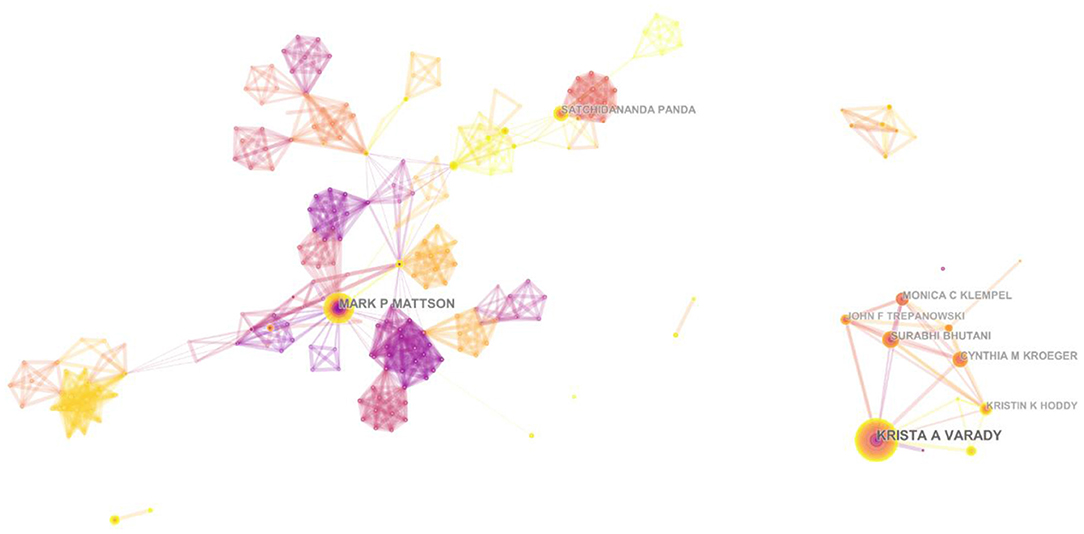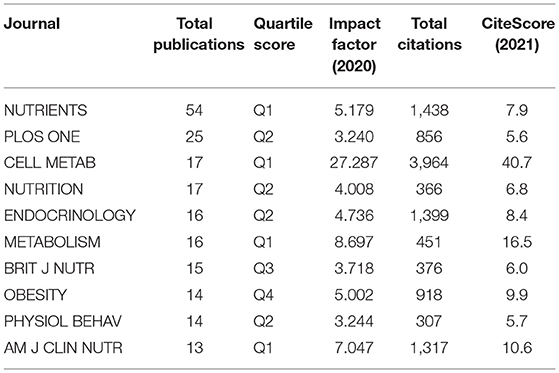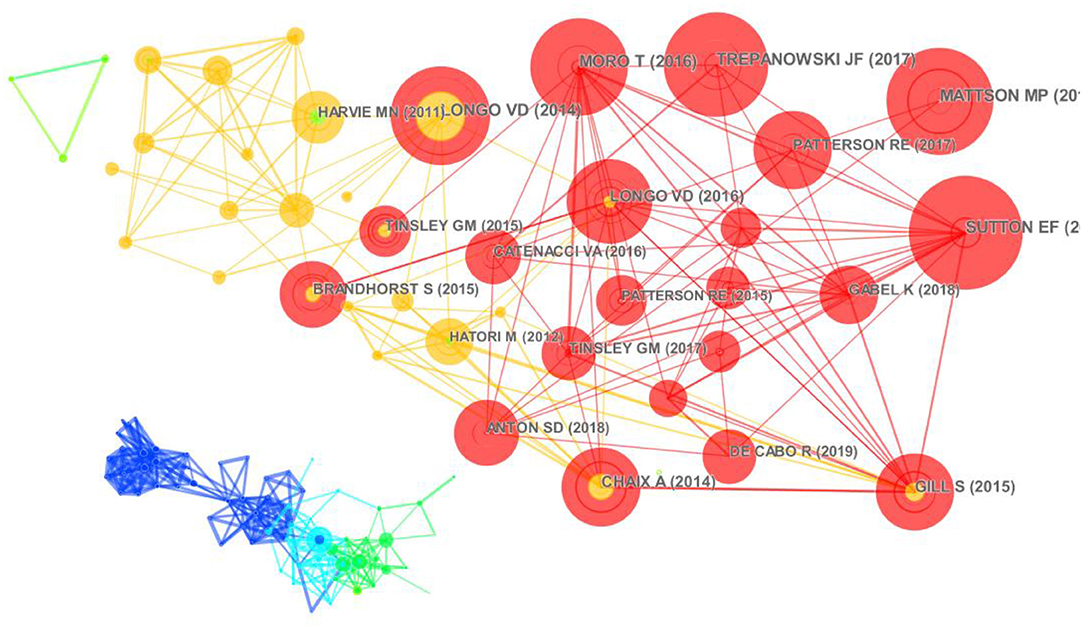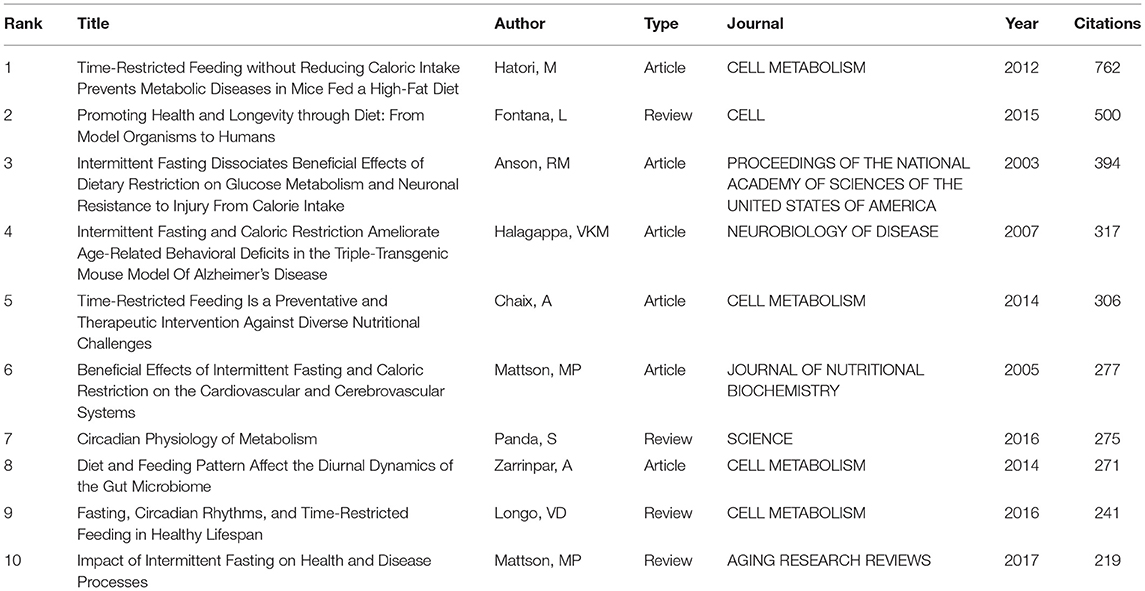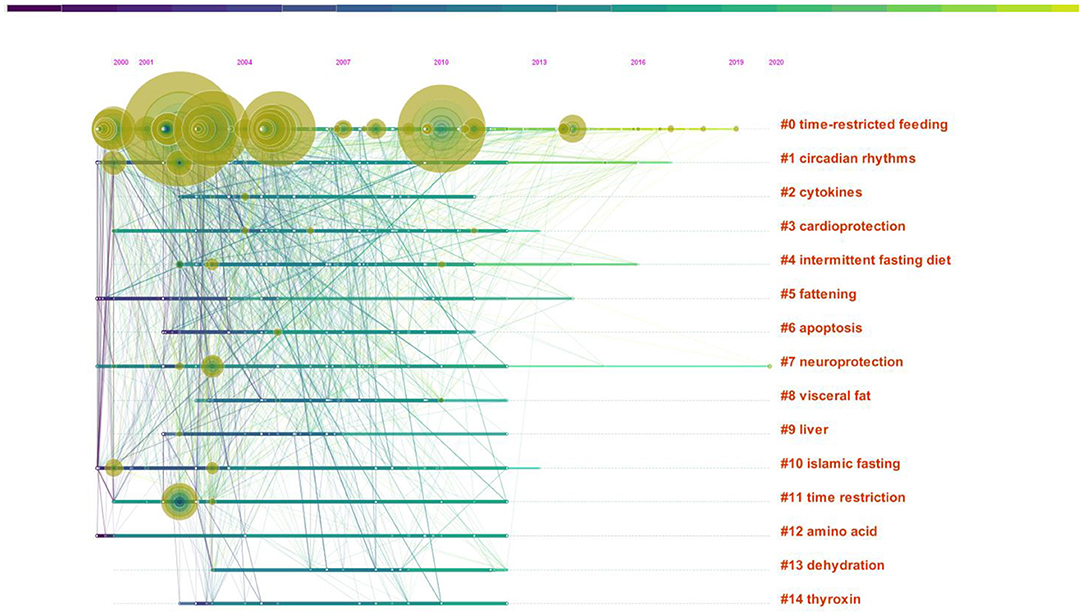- 1College of Physical Education, Henan University, Kaifeng, China
- 2Research Center for Sports Reform and Development, Henan University, Kaifeng, China
CiteSpace software was utilized to visually analyze the literature on intermittent fasting from Web of Science from 2000 to 2020 in order to reveal the current status, research hotspots and emerging trends of intermittent fasting. The results show that: (1) intermittent fasting research results are increasing year by year; (2) the United States is at the core of this field and has a high influence; (3) intermittent fasting research is mainly concentrated in the fields of nutrition, cell biology and kinesiology, which embodies interdisciplinary characteristics; (4) the literature of Sutton, Mattson and Trepanowski that were published in the same period have the highest co-citation frequencies, however, their research perspectives are quite different, reflecting that the research in this field is still in a state of continuous development; (5) from the perspective of citation bursts, the evolution of research hotspots in this field in the last 20 years can be divided into 3 stages; (6) the keyword timeline mapping shows that time restricted feeding is at the forefront of this research field. This study can help researchers explore the field for the first time to quickly grasp the frontiers and obtain more valuable data, thereby providing facilitation for the follow-up research.
Introduction
Modern humans are faced with complex health challenges, and the morbidity and mortality of metabolic diseases associated with obesity extremely affect the economy. As current treatments for obesity are limited and offer only modest improvements, it is essential to find a new way to treat obesity (1). Lifestyle changes are more convenient and less costly than pharmacological or surgical approaches. One recently popular dietary strategy, intermittent fasting (IF) that has many potential health benefits is a non-pharmacological strategy for obesity and related diseases (2, 3). Incorporating an IF lifestyle into adult daily life can promote health and reduce the risk of many chronic diseases, especially for those who are overweight and sedentary (4).
ADF regimens generally involve a “feast day” on which food is consumed ad libitum that alternates with a “fast day” on which food is withheld or reduced. The feast and fast periods are typically 24 h each, but they may vary.
Intermittent fasting refers to a dietary intervention that alternates between free-feeding and fasting in a continuous cycle (5–8). Most intermittent fasting therapies can be divided into three main categories (9). Alternate day fasting (ADF) programs typically involve a “festival” on which food is consumed arbitrarily, alternating with a “fasting day” in which no food is eaten or reduced on that day (10). Whole-day fasting (WDF) generally consists of one to two non-consecutive full fasting days per week, with free eating the rest of the time (11). Time restricted feeding (TRF) is when food intake is restricted to a specific part of the day and fasting the rest of the time (12). Although there are different forms of intermittent fasting, studies have demonstrated fasting is a sustainable and easy to implement lifestyle with many benefits for the body (13–23). Results from human studies suggest that IF cannot only prevent metabolic syndrome and related diseases, such as diabetes and cardiovascular disease (24–26), but also change body composition, promote cardiometabolic health and increase life expectancy (27–29). However, the mechanism remains unknown. The reasons for the potential effectiveness of IF include gut microbiota, oxidative stress, circadian rhythms, inflammation, insulin, and the brain derived neurotrophic factor (11, 30–33).
In recent years, studies on intermittent fasting have gradually increased, but most of them focus on the effect of intermittent fasting on a particular disease area. With the rapid development of intermittent fasting, we need to systematically understand the development process and research trends in the field, however, there is a lack of bibliometric and visualization analysis article on intermittent fasting. CiteSpace literature visualization and analysis software, which can reflect the research orientation of a field in the form of dynamic mapping (34). Therefore, this paper uses CiteSpace software to visually analyze the literature on intermittent fasting from 2000 to 2020, thus revealing the trends and research hotspots in this field, helping researchers explore this field for the first time to quickly grasp the frontiers of research in this field and obtain more valuable data, and providing new ideas to promote national health research.
Data Collection and Research Method
Data Collection
The Web of Science core collection of journal articles represents the highest level of international social science research. When CiteSpace was performed on visual analysis, the Web of Science database can present a better knowledge graph effect (35, 36). Therefore, this study retrieved the required literature from Web of Science Core Collection. As there are many foreign classifications of intermittent fasting, a relatively broad search topic was used to ensure the comprehensiveness of the literature. Using Web of Science as the data source, the search was conducted using “Intermittent fasting,” “Time-restricted feeding,” “short-term fasting,” “alternate day fasting” as the subject terms, and the time span was from 2000 to 2020, a total of 1,126 articles were retrieved. The full information of the literature (including title, abstracts, authors, keywords, document types, journals, year of publications and the cited references) was downloaded and exported to Ref-Works citation format. However, some pieces of literature lacked information, such as authors and references, so these records were excluded. Then, the exported literature information was imported into CiteSpace software for data preprocessing, such as filtering and duplication. Finally, a total of 1,106 effective pieces of literature are obtained (Figure 1).
Research Methods
CiteSpace software is an important analytical and visualization tool in the field of scientometrics, which can be used to explore the current state of research, research hotspots, evolutionary processes and disciplinary structure of a scientific field, so as to grasp the research direction of institutions and authors and judge the classical literature and related supporting studies (37, 38). The study was conducted using CiteSpace V. In this study, CiteSpace V (version: 5. 5. R2) was used to visualize and analyze the sample literature data in order to obtain the evolutionary relationship between intermittent fasting hotspots and the knowledge base. The processing parameters were set as follows: year interval 2000-2020, time slice of 1 year, country, institution, discipline, author, cited literature, etc. according to the topic of study, and threshold criterion of Top 50.
Results
Time Distribution
The number of articles published each year reflects the activity of the field and the importance given to a particular research area (39). The annual distribution of the literature on intermittent fasting over the past 20 years was obtained by counting the volume of literature on intermittent fasting during the period 2000–2020 (Figure 2). It shows that the overall trend of intermittent fasting-related literature is increasing year by year, indicating that scholars are gradually paying more attention to the field of intermittent fasting.
As can be seen from Figure 2, the development of intermittent fasting over the past two decades can be divided into two phases: phase 1 is a steady growth phase (2000–2016) with an annual average volume of 25 articles. Caloric restriction has been shown to have many benefits for the body since as early as 1935 (40). After 2000, a new dietary strategy, intermittent fasting, has been studied and proven to have beneficial effects on health (41, 42). The literature on intermittent fasting in this phase shows a steady increase.
Phase 2 is a period of sustained growth (2017–2020), with an average of 167 publications per year, which is at a high level, indicating the rising research fervor and importance of intermittent fasting. The number of publications exceeds 100 for the first time in 2017 and reaches a 20-year peak in 2020. Mattson's 2017 review of the effects of intermittent fasting on health and disease processes has attracted widespread scholarly attention and driven the rapid development of intermittent fasting (24). Intermittent fasting has become a popular dietary strategy. As people become more concerned about their health and quality of life, diet is a key part of health promotion to drive the development of diet and health-related research (43). Research related to intermittent fasting will continue to receive extensive attention from scholars, and research in this area will be progressively deepened.
Spatial Distribution
Country Distribution
The parameter “Country” was selected in CiteSpace and a knowledge map of the national/regional cooperation networks in the field of intermittent fasting was obtained (Figure 3). Each node represents a country (region), and the size of the node is proportional to the number of articles published; the lines connecting the nodes represent the connections between them, and the thickness of the lines is proportional to the closeness of their connections; the outermost circle represents centrality, which is a measure of the size of the connections in the knowledge graph network, and is the hub of communication with other literature nodes (44). Combining the results of the software analysis, the TOP 10 countries in the field of intermittent fasting were compiled (Table 1).
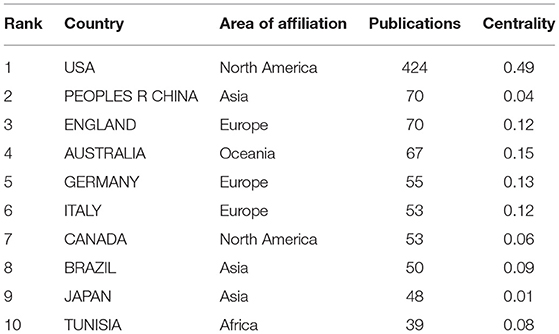
Table 1. Top 10 countries (regions) in terms of number of publications in the field of intermittent fasting research.
One thousand and one hundred-six English-language articles in this field were from 102 countries (regions). Table 1 presents the top 10 countries (regions) in the field of intermittent fasting research according to the number of publications. The United States is the center of global cooperation in this field and cooperates most closely with other countries and regions due to the highest publications (424 articles, accounting for 38.34% of the literature sample). According to the theory of the Yuasa phenomenon (45), the country whose research results account for more than 25% of the total number of scientific results at a given time can be called the world center of science for that period, the United States, as the leading country in intermittent fasting research, has published more than a quarter of the total number of articles and is the world scientific center in the field of intermittent fasting. China (70), England (70), Australia (67) and Germany (55) followed closely in terms of volume. When analyzing in terms of centrality, the USA (0.49) was ranked first, followed by the European countries of Australia (0.15), Germany (0.13), Italy (0.12) and England (0.12). The high-centeredness country has an important place in the study of intermittent fasting, and it is worth noting that countries such as Italy, Germany and Australia, although the volume of articles is small, but the impact is large.
European and American countries have a high influence in this field, compared with China's 2nd place in the number of articles and 0.04 centrality, indicating that although China's ranking in the number of articles is at the top, it is less connected in the network map and has a lower influence. Therefore, increasing the depth of intermittent fasting research, accelerating multidisciplinary and multi-disciplinary cooperation, and enhancing the innovative thinking and international exchange ability of researchers are effective ways to improve research of intermittent fasting in China.
Distribution of Issuing Institutions
Figure 4 is a co-occurrence diagram of research institutions consisting of 813 nodes and 1,723 connecting lines. The nodes represent research institutions and the connecting lines between nodes reveal the cooperation between institutions; the thicker the line, the stronger the cooperation. It has many lines between nodes, indicating close cooperation between institutions.
Research institutions with a high frequency of publications are identified as influential institutions (46). Table 2 collates the top 15 research institutions in the field of intermittent fasting research in terms of the number of publications, which are the influential research institutions in the field of intermittent fasting. The results show that universities are the mainstay of intermittent fasting research. Among them, National Institute on Aging (NIA) has the highest number of articles (47), the highest centrality (0.22) and the most prominent impact. The United States accounted for 73.33% of the top 15 research institutions in terms of the number of articles published, further demonstrating its leadership role in the field of intermittent fasting research.
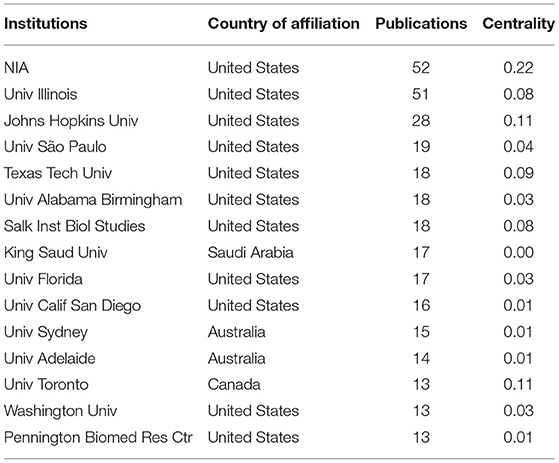
Table 2. Top 15 institutions in the field of intermittent fasting research in terms of number of publications.
Discipline Analysis
By using the “Category” node of CiteSpace to perform disciplinary co-occurrence operations, we can obtain a knowledge map of disciplines related to intermittent fasting research (Figure 5). Knowledge mapping of disciplines may provide a first glimpse into the broad international classification of intermittent fasting in terms of disciplines. The order based on the frequency of discipline source are as follows: nutrition (262 times, centrality 0.14), endocrinology (184 times, centrality 0.08), cell biology (139 times, centrality 0.21), neurology (112 times, centrality 0.4), molecular biology (102 times, centrality 0.65), and sports science (67 times, centrality 0). The distribution of disciplines shows that intermittent fasting is a multidisciplinary field of study, combining the characteristics of multiple disciplines such as nutrition, biology and sports. At the same time, there has been a major trend toward the use of multidisciplinary cross-sectional trials for the study of intermittent fasting, which has also promoted further developments in this area.
Highly Productive Paper Authors
Using CiteSpace software to analyze the co-author collaboration network, we can get the knowledge map of co-author collaboration network. As can be seen in Figure 6, the authorship of intermittent fasting research is relatively stable, with author groups usually containing two or more core authors. The field of intermittent fasting has formed a core group of academic teams such as VARADY and MATTSON respectively. Table 3 presents the top 10 authors in terms of the number of publications. Professor Varady has published 48 publications, ranking first and second in total citations (2,699), and his study included in Cell Metabolism in 2020 compared the effects of two popular forms of TRF (4 and 6 h) on weight and cardio metabolic risk factors and found restricted feeding promises to be an effective weight loss intervention (48). With MATTSON as the core team, the number of Publications (37) ranked second, H-index (49), the total number of citations(5,758)and average citations (156) ranked first. And the network of cooperation is dense, with a number of teams to form close cooperation.

Table 3. Top 10 authors in the field of intermittent fasting in terms of number of published articles.
As a whole, the author collaboration map shows a large concentration and a small fragmentation, indicating a large collaboration pattern have been established, whereby these teams, as the key force of studying intermittent fasting, play an important role in advancing the development of this field.
Journal Distribution
Analyzing the source journals of a certain research field can help researchers grasp the core journals of this field accurately and provide reliable reference sources for further research in this field (50). Table 4 shows the 10 journals with the most published articles. Among them, NUTRIENTS, PLOS ONE, CELL METAB, NUTRITION and ENDOCRINOLOGY are the top five journals. NUTRIENTS published the most articles, the second most total citations. The number of published articles in CELL METAB ranked third, but the Total Citations (3,964), Impact Factor (27.287) and CiteScore (40.7) ranked first. This phenomenon indicates that the academic papers published by CELL METAB are of high quality and have great influence.
Literature Co-citation Analysis
Literature co-citations are used to assess the impact of literature. The time slice was set to 3 years, and the data of the top 20 citation frequency in each time slice were extracted, and there was a total of 339 nodes and 1,087 links. The size of the nodes is closely related to the frequency of citations, and the thickness of the line between the nodes indicates the closeness of the connection. As seen in Figure 7, Sutton et al. (15) had the largest literature node with 87 citations, ranking first. The researcher conducted a clinical trial of early time restricted feeding (e-TRF) on eight pre-diabetic men; the study found that when taking the same food intake as the control group, subjects did not lose weight but improved insulin levels, insulin sensitivity, suggesting that the benefits of time restricted feeding were not related to food intake and weight loss. The second most cited literature is the article published by Mattson et al. (24); this study provides a systematic review of the literature on fasting and indicates that time restricted feeding therapy has a positive impact on health indicators in both animals and humans, as well as improving many health indicators in healthy individuals and those with certain chronic conditions; in the meantime, this publication has been accepted for publication. The third cited literature is the article by Trepanowski et al. with a total of 79 citations (42), which stated that alternate-day fasting did not produce better results when compared to daily calorie restriction trials. Also, this trial was the longest lasting and largest trial. All three papers were published in the same phase and had high co-citation frequency, but the research perspectives were quite different, which reflects the different opinions of intermittent fasting. Therefore, IF field is still evolving.
Literature Analysis
The top cited article was published in CELL METABOLISM in 2012 by Hatori, M, with a total of 762 citations. Among the top 10 papers with the most citations, the highest journal-level article was published in SCIENCE by Panda, S in 2016. Of the top 10 highly cited articles, four of them were published in the journal CELL METABOLISM, and there were four reviews and six articles in them (Table 5).
Emerging Trends and Research Frontiers in Intermittent Fasting
Emerging Trends
CiteSpace offers burst detection, which detects when relevant literature has attracted the relevant attention in the field for a certain period of time (51). References with high intensity values in the intensity column are often important milestones in scientific mapping research (52). Thus, the focus of the intermittent fasting research field can be found. The top 12 literature with the highest citation intensity from 2000 to 2020 are listed in Figure 8, highlighting the direction of focus and research trends in intermittent fasting over the last 20 years. Of these 12 articles, seven were clinical studies, three animal studies, and two reviews, most of which were RCT studies.
Since 2004, the field has focused mainly on caloric restriction research. Anson et al. (41) compared intermittent fasting with a caloric restriction protocol and found that intermittent fasting produced health benefits that outweighed caloric restriction. Subjects often spontaneously tend to eat less globally as there were fewer food opportunities. But a study found that intermittent fasting also had beneficial effects on glucose regulation and resistance to neuronal damage in mice, and these benefits were independent of calorie intake.
The trend in intermittent fasting research after 2013 shifted to studies of alternate day fasting. Varady et al. (53) conducted studies on humans and found that alternate-day fasting had a weight loss and cardioprotective effect in normal weight people, and that dietary adherence was high in this trial. Bhutani et al. (17) compared ADF combined with endurance training with ADF alone, an exercise intervention, and found that ADF combined with endurance training produced better changes in body weight, body composition and lipid indicators of coronary heart disease risk. Although ADF combined with a low-fat diet can be effective for weight loss and cardio protection. Given that most Americans consume a high-fat (HF) diet, Klempel et al. (47) explored the physical effects of consuming a high-fat diet during ADF and found that ADF, even in a high-fat setting, can also help obese people to lose weight and reduce the risk factors for coronary heart disease.
After 2018, intermittent fasting studies focused on ADF and TRF studies, which focused more on safety studies of fasting and more flexible forms of fasting, while, at the same time, began to experiment with studies in various populations. Longo et al. (12) noted that PF, TRF and IF have profound beneficial effects on rodent and human health. In rodents, intermittent or periodic fasting prevents diabetes, cancer, heart disease and neurodegeneration (41). In human studies, intermittent fasting has helped with obesity, hypertension, asthma and rheumatoid arthritis. Incorporating an IF or PF lifestyle into adult life has great potential to promote optimal health and reduce the risk of many chronic diseases, especially for those who are overweight and sedentary. Mattson et al. (24) reviewed the effects of intermittent fasting on health and disease processes and also confirmed the many benefits of intermittent fasting. Catenacci et al. (54) point out that alternate day eating is safe and tolerable and is a reasonable alternative dietary strategy for the treatment of obesity. However, Trepanowski et al. (42) compared alternate-day fasting with daily calorie-restricted diets and found that alternate-day fasting was not superior to daily calorie-restricted diets in terms of compliance, weight loss, weight maintenance or improvements in cardiovascular disease risk indicators. Chaix et al. (1) concluded that TRF has great potential in combating obesity and its associated metabolic disorders. Although TRF emphasizes the benefits of daily fasting cycles, the 5T2A approach (5 days of TRF combined with a two-day casual diet at weekends) is equally effective and the food intake of 5T2A is almost identical to that of the cycle, suggesting that TRF diets can resist occasional changes in eating patterns. That is, even occasional shifts in dietary patterns do not diminish the benefits of TRF. However, when mice transiting from TRF to free-feeding mode, the benefits of TRF were gradually diminished. Conversely, mice with gradual transition from free-feeding to a time restricted feeding pattern can effectively alleviate the adverse health conditions associated with obesity. The results of this study suggest that TRF interventions have a positive effect on bodybuilder performance and athletes can adopt this diet during the maintenance phase of training, which facilitates the reduction of fat mass while maintaining muscle mass (55).
The focus of research in this area over the last 20 years is roughly divided into three phases in terms of the 12 most highly cited papers: Phase 1 (2004–2008), which focused on the study of caloric restriction for human health. In the second phase (2013–2017), the trend in intermittent fasting research shifted to research on alternate-day fasting. In the third phase (2018–2020), the focus in this period was on alternate-day fasting and time restricted feeding, but the difference is that the research in this period went deeper and began to compare the compliance, safety and health benefits of dietary practices, thus exploring a better way of eating to serve the health of diverse populations.
Frontiers of Research
The timeline view focuses on reflecting the relationships between clusters and the historical span of the literature in a given cluster, and also reflects the timing of distribution and connection of key keywords between clusters (56, 57). Figure 9 shows the timeline mapping of keywords in the field of intermittent fasting research from 2000–2020. The key parameters of clustering are Modularity Q value of 0.6,512 > 0.3 and S-value of 0.5,675 > 0.5, which can indicate the formation of reasonable clusters (58). The figure shows that time restricted feeding has been active since 2000 and is closely linked to other clusters and is at the forefront of research in this area. Time restricted feeding is a non-pharmacological technique for obesity and related diseases (2), which has been shown to have a significant effect on improved quality of life (59). Time restricted feeding is mainly used to achieve weight loss by reducing appetite (60). Besides preventing obesity and improving metabolic disease (61–65), time restricted feeding can improve blood sugar, lipid metabolism, and chronic diseases (49, 66–68). It is worth noting that in the restricted eating state, the benefits of 2 days of random eating in a week in subjects are also beneficial to the organism (2), and time restricted eating is beneficial to human health even in the absence of weight loss (69).
Conclusions
On the basis of 11,066 intermittent fasting studies from WOS from 2000 to 2020, CiteSpace was utilized to visually analyze the volume of articles published, distribution characteristics (country/region, institution), collaborations (country/region, institution, author), literature co-citations, and the frontiers of intermittent fasting research and trends. The main findings of this study are as follows:
Firstly, the number of articles in the field of intermittent fasting is increasing year by year. From the graph of the temporal distribution, intermittent fasting studies can be divided into two phases: phase 1 is the steady growth phase (2000–2016), during this period, the number of publications is slowly increasing; phase 2 is the continuous growth phase (2017–2020), in which there was a surge in the number of publications with an average of 167 publications per year, indicating the popularity and importance of intermittent fasting. This trend is also supported by the extensive literature on intermittent fasting since 2021.
Secondly, the United States has significantly higher publication volume and more influence than other countries, and maintains close cooperation with other countries and regions, indicating that the United States plays an important role in IF field. Although China ranks 2nd in the number of publications, however, the level of academic collaboration in this field is much lower than that of other countries; therefore, cooperation between international institutions needs to be strengthened.
Thirdly, intermittent fasting is typically an interdisciplinary study, numerous disciplinary categories are involved, mainly covering the disciplines of nutrition, biology and kinesiology. Most of the scholars who have participated and made outstanding contributions to intermittent fasting research have a medical background. For example, the representative American scholar Professor Mattson is at the National Institutes of Health. However, there is no shortage of scholars with a sports background, such as Professor Varady, a faculty member in the Department of Exercise and Nutrition at the University of Illinois, who is the most published scholar in the field of intermittent fasting and has made outstanding contributions to this field.
Fourthly, intermittent fasting has a variety of modalities and the impact of applying this dietary strategy has been inconsistent. Intermittent fasting has received considerable attention in the past few years, but its safety and compliance has been questioned (70, 71). However, the use of intermittent fasting in China has been viewed with caution. Most of the studies on intermittent fasting in China are literature reviews and animal studies.
Fifthly, the focus of intermittent fasting research has gone through three phases over the past two decades: caloric restriction, alternate-day eating, and time restricted eating. Time-restricted eating has been active for two decades and is the focus of current research in this field, which is strongly linked to the promotion of physical health.
In 2020, Professor Wilkinson found that TRE interventions, which do not require attempts to change physical activity or diet, can also have a positive effect on the treatment of metabolic syndrome (3). Professor Ulgherait in the journal NATURE in 2021. It suggests that TRF may have benefits in delaying aging and prolonging life (72). A 2022 study by Professor Mao YL showed that TRF not only improves fasting blood glucose and inflammation, but also increases intestinal microbial diversity (73) and be expected to become health-promoting lifestyle (48). The above studies suggest that the culmination of research on time restricted eating in intermittent fasting is imminent.
The field of intermittent fasting research has achieved a rapid growth over the past 20 years, and the growing literature on intermittent fasting each year indicates that the field has become a research hotspot in recent years. The interdisciplinary research context of intermittent fasting will facilitate international cooperation among scholars to find more scientific, non-pharmacological techniques. The penetration of intermittent fasting into people's health may change our existing lifestyle. Time restricted eating does not restrict caloric intake, therefore, it can become an easily accepted and healthy lifestyle.
Data Availability Statement
The original contributions presented in the study are included in the article/supplementary material, further inquiries can be directed to the corresponding author/s.
Author Contributions
HL was responsible for concept, design, and supervision. SC collected data from the database and wrote the original draft preparation. HL and RH took the responsibility of critical revision. All authors contributed to the article and approved the submitted version.
Funding
This work was supported by Henan Science and Technology Development Project grants (202102310320), Henan Science and Technology Development Project grants (212102310260), Henan Education Science Planning Project grants (2021YB0031), Henan Higher Education Institutions Project grants (20A890003).
Conflict of Interest
The authors declare that the research was conducted in the absence of any commercial or financial relationships that could be construed as a potential conflict of interest.
Publisher's Note
All claims expressed in this article are solely those of the authors and do not necessarily represent those of their affiliated organizations, or those of the publisher, the editors and the reviewers. Any product that may be evaluated in this article, or claim that may be made by its manufacturer, is not guaranteed or endorsed by the publisher.
References
1. Chaix A, Zarrinpar A, Miu P, Panda S. Time-restricted feeding is a preventative and therapeutic intervention against diverse nutritional challenges. Cell Metab. (2014) 20:991–1005. doi: 10.1016/j.cmet.2014.11.001
2. Hatori M, Vollmers C, Zarrinpar A, DiTacchio L, Bushong EA, Gill S, et al. Time-restricted feeding without reducing caloric intake prevents metabolic diseases in mice fed a high-fat diet. Cell Metab. (2012) 15:848–60. doi: 10.1016/j.cmet.2012.04.019
3. Wilkinson MJ, Manoogian ENC, Zadourian A, Lo H, Fakhouri S, Shoghi A, et al. Ten-hour time-restricted eating reduces weight, blood pressure, and atherogenic lipids in patients with metabolic syndrome. Cell Metab. (2020) 31:92. doi: 10.1016/j.cmet.2019.11.004
4. Longo VD, Mattson MP. Fasting: molecular mechanisms and clinical applications. Cell Metab. (2014) 19:181–92. doi: 10.1016/j.cmet.2013.12.008
5. Wang JY, Zhang AR. Role of gut microbiome and intermittent fasting in the treatment of obesity. Chin Gen Pract. (2019) 22:3308–11.
6. Martinez-Rodriguez A, Rubio-Arias JA, Garcia-De Frutos JM, Vicente-Martinez M, Gunnarsson TP. Effect of high-intensity interval training and intermittent fasting on body composition and physical performance in active women. Int J Environ Res Public Health. (2021) 18:6431. doi: 10.3390/ijerph18126431
7. Longo VD, Di Tano M, Mattson MP, Guidi N. Intermittent and periodic fasting, longevity and disease. Nat Aging. (2021) 1:47–59. doi: 10.1038/s43587-020-00013-3
8. Stratton MT, Albracht-Schulte K, Harty PS, Siedler MR, Rodriguez C, Tinsley GM. Physiological responses to acute fasting: implications for intermittent fasting programs. Nutr Rev. (2022) 80:439–52. doi: 10.1093/nutrit/nuab094
9. Tinsley GM, La Bounty PM. Effects of intermittent fasting on body composition and clinical health markers in humans. Nutr Rev. (2015) 73:661–74. doi: 10.1093/nutrit/nuv041
10. Varady KA, Hellerstein MK. Alternate-day fasting and chronic disease prevention: a review of human and animal trials. Am J Clin Nutr. (2007) 86:7–13. doi: 10.1093/ajcn/86.1.7
11. Currenti W, Godos J, Castellano S, Mogavero MP, Ferri R, Caraci F, et al. Time restricted feeding and mental health: a review of possible mechanisms on affective and cognitive disorders. Int J Food Sci Nutr. (2021) 72:723–33. doi: 10.1080/09637486.2020.1866504
12. Longo VD, Panda S. Fasting, circadian rhythms, and time-restricted feeding in healthy lifespan. Cell Metab. (2016) 23:1048–59. doi: 10.1016/j.cmet.2016.06.001
13. Feng H, Wang X, Li DW, Qiu B, Xu TC. Research progress of the effects of fast diet on the human health. Food Sci Technol. (2020) 41:351–360. doi: 10.13386/j.issn1002-0306.2020.20.058
14. Jamshed H, Beyl RA, Della Manna DL, Yang ES, Ravussin E, Peterson CM. Early time-restricted feeding improves 24-hour glucose levels and affects markers of the circadian clock, aging, and autophagy in humans. Nutrients. (2019) 11:1234. doi: 10.3390/nu11061234
15. Sutton EF, Beyl R, Early KS, Cefalu WT, Ravussin E, Peterson CM. Early time-restricted feeding improves insulin sensitivity, blood pressure, and oxidative stress even without weight loss in men with prediabetes. Cell Metab. (2018) 27:1212–21.e3. doi: 10.1016/j.cmet.2018.04.010
16. Heilbronn LK, Smith SR, Martin CK, Anton SD, Ravussin E. Alternate-day fasting in nonobese subjects: effects on body weight, body composition, and energy metabolism. Am J Clin Nutr. (2005) 81:69–73. doi: 10.1093/ajcn/81.1.69
17. Bhutani S, Klempel MC, Kroeger CM, Trepanowski JF, Varady KA. Alternate day fasting and endurance exercise combine to reduce body weight and favorably alter plasma lipids in obese humans: alternate day fasting and exercise for weight loss. Obesity. (2013) 21:1370–9. doi: 10.1002/oby.20353
18. Zouhal H, Bagheri R, Triki R, Saeidi A, Wong A, Hackney AC, et al. Effects of ramadan intermittent fasting on gut hormones and body composition in males with obesity. Int J Environ Res Public Health. (2020) 17:5600. doi: 10.3390/ijerph17155600
19. Charlot A, Hutt F, Sabatier E, Zoll J. Beneficial effects of early time-restricted feeding on metabolic diseases: importance of aligning food habits with the circadian clock. Nutrients. (2021) 13:1405. doi: 10.3390/nu13051405
20. Davis JA, Paul JR, Yates SD, Cutts EJ, McMahon LL, Pollock JS, et al. Time-restricted feeding rescues high-fat-diet-induced hippocampal impairment. Iscience. (2021) 24:102532. doi: 10.1016/j.isci.2021.102532
21. Currenti W, Godos J, Castellano S, Caruso G, Ferri R, Caraci F, et al. Association between time restricted feeding and cognitive status in older italian adults. Nutrients. (2021) 13:191. doi: 10.3390/nu13010191
22. Guo Y, Luo S, Ye Y, Yin S, Fan J, Xia M. Intermittent fasting improves cardiometabolic risk factors and alters gut microbiota in metabolic syndrome patients. J Clin Endocrinol Metab. (2021) 106:64–79. doi: 10.1210/clinem/dgaa644
23. Dias GP, Murphy T, Stangl D, Ahmet S, Morisse B, Nix A, et al. Intermittent fasting enhances long-term memory consolidation, adult hippocampal neurogenesis, and expression of longevity gene. Klotho Mol Psychiatry. (2021) 26:6365–79. doi: 10.1038/s41380-021-01102-4
24. Mattson MP, Longo VD, Harvie M. Impact of intermittent fasting on health and disease processes. Ageing Res Rev. (2017) 39:46–58. doi: 10.1016/j.arr.2016.10.005
25. Zang B-Y, He L-X, Xue L. Intermittent fasting: potential bridge of obesity and diabetes to health? Nutrients. (2022) 14:981. doi: 10.3390/nu14050981
26. Wang C, Zhang X, Luo L, Luo Y, Yang X, Ding X, et al. Adipocyte-derived PGE(2) is required for intermittent fasting-induced Treg proliferation and improvement of insulin sensitivity. JCI Insight. (2022) 7:153755. doi: 10.1172/jci.insight.153755
27. Domaszewski P, Konieczny M, Pakosz P, Baczkowicz D, Sadowska-Krepa E. Effect of a six-week intermittent fasting intervention program on the composition of the human body in women over 60 years of age. Int J Environ Res Public Health. (2020) 17:4138. doi: 10.3390/ijerph17114138
28. Zarrinpar A, Chaix A, Yooseph S, Panda S. Diet and feeding pattern affect the diurnal dynamics of the gut microbiome. Cell Metab. (2014) 20:1006–17. doi: 10.1016/j.cmet.2014.11.008
29. Lin Y-J, Wang Y-T, Chan L-C, Chu N-F. Effect of time-restricted feeding on body composition and cardiometabolic risk in middle-aged women in Taiwan. Nutrition. (2022) 93:111504. doi: 10.1016/j.nut.2021.111504
30. Currenti W, Buscemi S, Cincione RI, Cernigliaro A, Godos J, Grosso G, et al. Time-restricted feeding and metabolic outcomes in a cohort of Italian adults. Nutrients. (2021) 13:1651. doi: 10.3390/nu13051651
31. Varady KA, Cienfuegos S, Ezpeleta M, Gabel K. Cardiometabolic benefits of intermittent fasting. In: Stover PJ, Balling R, editors. Annual Review of Nutrition. Vol 41. Palo Alto: Annual Reviews. (2021). p. 333–61 doi: 10.1146/annurev-nutr-052020-041327
32. Panda S. Circadian physiology of metabolism. Science. (2016) 354:1008–15. doi: 10.1126/science.aah4967
33. Fontana L, Partridge L. Promoting health and longevity through diet: from model organisms to humans. Cell. (2015) 161:106–18. doi: 10.1016/j.cell.2015.02.020
34. Chen C. CiteSpace II: Detecting and visualizing emerging trends and transient patterns in scientific literature. J Am Soc Inf Sci Technol. (2006) 57:359–77. doi: 10.1002/asi.20317
35. Martin-Martin A, Orduna-Malea E, Thelwall M, Delgado Lopez-Cozar E. Google Scholar, web of science, and scopus: a systematic comparison of citations in 252 subject categories. J Informetr. (2018) 12:1160–77. doi: 10.1016/j.joi.2018.09.002
36. Falagas ME, Pitsouni EI, Malietzis GA, Pappas G. Comparison of PubMed, Scopus, web of science, and Google Scholar: strengths and weaknesses. FASEB J. (2008) 22:338–42. doi: 10.1096/fj.07-9492LSF
37. Wang L, Xue X, Zhang Y, Luo X. Exploring the emerging evolution trends of urban resilience research by scientometric analysis. Int J Environ Res Public Health. (2018) 15:2181. doi: 10.3390/ijerph15102181
38. Gao J, Wu X, Luo X, Guan S. Scientometric Analysis of safety sign research: 1990-2019. Int J Environ Res Public Health. (2021) 18:273. doi: 10.3390/ijerph18010273
39. Qi Q. The Retrieval and Application of Web of Science. Library Work and Study. (2013) 2:110–2. doi: 10.16384/j.cnki.lwas.2013.02.030
40. Martin B, Mattson MP, Maudsley S. Caloric restriction and intermittent fasting: Two potential diets for successful brain aging. Ageing Res Rev. (2006) 5:332–53. doi: 10.1016/j.arr.2006.04.002
41. Anson RM, Guo Z, de Cabo R, Iyun T, Rios M, Hagepanos A, et al. Intermittent fasting dissociates beneficial effects of dietary restriction on glucose metabolism and neuronal resistance to injury from calorie intake. Proc Natl Acad Sci. (2003) 100:6216–20. doi: 10.1073/pnas.1035720100
42. Trepanowski JF, Kroeger CM, Barnosky A, Klempel MC, Bhutani S, Hoddy KK, et al. Effect of alternate-day fasting on weight loss, weight maintenance, and cardioprotection among metabolically healthy obese adults: a randomized clinical trial. JAMA Intern Med. (2017) 177:930. doi: 10.1001/jamainternmed.2017.0936
43. Peng YL, Yang J, Yan JH. Current status of research on lifestyle and physical health of university students at home and abroad. Chin J Sch Health. (2020) 41:1583–7.
44. Feng GH, Li MC. Research on visual analysis of archival science based on Citespace. Archives Science Study. (2014) 5:18–23.
45. Shi GJ, Geng Y. Science is flat: new explanation of Yuasa phenomenon. Stud Sci Educ. (2012) 30:1770–80.
46. Dang Q, Luo Z, Ouyang C, Wang L. First systematic review on health communication using the CiteSpace software in China: exploring its research hotspots and frontiers. Int J Environ Res Public Health. (2021) 18:13008. doi: 10.3390/ijerph182413008
47. Klempel MC, Kroeger CM, Varady KA. Alternate day fasting. (ADF) with a high-fat diet produces similar weight loss and cardio-protection as ADF with a low-fat diet Metabolism. (2013) 62:137–43. doi: 10.1016/j.metabol.2012.07.002
48. Cienfuegos S, Gabel K, Kalam F, Ezpeleta M, Wiseman E, Pavlou V, et al. Effects of 4- and 6-h time-restricted feeding on weight and cardiometabolic health: a randomized controlled trial in adults with obesity. Cell Metab. (2020) 32:366–78.e3. doi: 10.1016/j.cmet.2020.06.018
49. Shi H, Zhang B, Abo-Hamzy T, Nelson JW, Ambati CS, Petrosino JF. Restructuring the Gut Microbiota by Intermittent Fasting Lowers Blood Pressure. Circ Res. (2022) 128:1240–54. doi: 10.1161/CIRCRESAHA.120.318155
50. Shi D, Xie C, Wang J, Xiong L. Changes in the structures and directions of heavy metal-contaminated soil remediation research from 1999 to 2020: a bibliometric & scientometric study. Int J Environ Res Public Health. (2021) 18:7358. doi: 10.3390/ijerph18147358
51. Kleinberg J. Bursty and hierarchical structure in streams. Data Min Knowl Discov. (2003) 7:373–97. doi: 10.1023/A:1024940629314
52. Chen C. Science mapping: a systematic review of the literature. J Data Inf Sci. (2017) 2:1–40. doi: 10.1515/jdis-2017-0006
53. Varady KA, Bhutani S, Klempel MC, Kroeger CM, Trepanowski JF, Haus JM, et al. Alternate day fasting for weight loss in normal weight and overweight subjects: a randomized controlled trial. Nutr J. (2013) 12:146. doi: 10.1186/1475-2891-12-146
54. Catenacci VA, Pan Z, Ostendorf D, Brannon S, Gozansky WS, Mattson MP, et al. Randomized pilot study comparing zero-calorie alternate-day fasting to daily caloric restriction in adults with obesity: alternate-day fasting vs. caloric restriction. Obesity. (2016) 24:1874–83. doi: 10.1002/oby.21581
55. Moro T, Tinsley G, Bianco A, Marcolin G, Pacelli QF, Battaglia G, et al. Effects of eight weeks of time-restricted feeding. (16/8) on basal metabolism, maximal strength, body composition, inflammation, and cardiovascular risk factors in resistance-trained males. J Transl Med. (2016) 14:290. doi: 10.1186/s12967-016-1044-0
56. Huang XB, Wu G. Research review of frontier detection methods in subject fields. J Chin Technol. (2019) 38:872–80.
57. Chen CM. Searching for intellectual turning points: progressive knowledge domain visualization. Proc Natl Acad Sci U S A. (2004) 101:5303–10. doi: 10.1073/pnas.0307513100
58. Chen Y, Chen CM, Liu ZY, Hu ZG, Wang XW. The methodology function of Cite Space mapping knowledge do-mains. Stud Sci Educ. (2015) 33:242–53. doi: 10.16192/j.cnki.1003-2053.2015.02.009
59. Anton SD, Lee SA, Donahoo WT, McLaren C, Manini T, Leeuwenburgh C, et al. The effects of time restricted feeding on overweight, older adults: a pilot study. Nutrients. (2019) 11:E1500. doi: 10.3390/nu11071500
60. Ravussin E, Beyl RA, Poggiogalle E, Hsia DS, Peterson CM. Early Time-restricted feeding reduces appetite and increases fat oxidation but does not affect energy expenditure in humans. Obes Silver Spring Md. (2019) 27:1244–54. doi: 10.1002/oby.22518
61. Chaix A, Lin T, Le HD, Chang MW, Panda S. Time-restricted feeding prevents obesity and metabolic syndrome in mice lacking a circadian clock. Cell Metab. (2019) 29:303–19.e4. doi: 10.1016/j.cmet.2018.08.004
62. Chaix A, Manoogian ENC, Melkani GC, Panda S. Time-restricted eating to prevent and manage chronic metabolic diseases. Annu Rev Nutr. (2019) 39:291–315. doi: 10.1146/annurev-nutr-082018-124320
63. Parr EB, Devlin BL, Radford BE, Hawley JA. A delayed morning and earlier evening time-restricted feeding protocol for improving glycemic control and dietary adherence in men with overweight/obesity: a randomized controlled trial Nutrients. (2020) 12:505. doi: 10.3390/nu12020505
64. Wong–Gonzales J, Quispe-Palacios JA. Scheme of intermittent fasting and reduction of anthropometric measures, lipid profile, blood pressure and cardiovascular risk. Rev Fac Med Humana. (2021) 22:139–146. doi: 10.25176/RFMH.v22i1.4383
65. Moro T, Tinsley G, Pacelli FQ, Marcolin G, Bianco A, Paoli A. Twelve months of time-restricted eating and resistance training improves inflammatory markers and cardiometabolic risk factors. Med Sci Sports Exerc. (2021) 53:2577–85. doi: 10.1249/MSS.0000000000002738
66. Hutchison AT, Regmi P, Manoogian ENC, Fleischer JG, Wittert GA, Panda S, et al. Time-restricted feeding improves glucose tolerance in men at risk for type 2 diabetes: a randomized crossover trial. Obesity. (2019) 27:724–32. doi: 10.1002/oby.22449
67. Santos HO, Genario R, Macedo RCO, Pareek M, Tinsley GM. Association of breakfast skipping with cardiovascular outcomes and cardiometabolic risk factors: an updated review of clinical evidence. Crit Rev Food Sci Nutr. (2021) 62:466–74. doi: 10.1080/10408398.2020.1819768
68. Bitsanis D, Giannakou K, Hadjimbei E, Chrysostomou S. The effect of early time-restricted feeding on glycemic profile in adults: a systematic review of interventional studies. Rev Diabet Stud. (2022) 18:10–9. doi: 10.1900/RDS.2022.18.10
69. Parr EB, Devlin BL, Hawley JA. Perspective: time-restricted eating—integrating the what with the when. Adv Nutr. (2022) 13:699–711. doi: 10.1093/advances/nmac015
70. Gabel K, Hoddy KK, Varady KA. Safety of 8-h time restricted feeding in adults with obesity. Appl Physiol Nutr Metab. (2019) 44:107–9. doi: 10.1139/apnm-2018-0389
71. Varady KA, Gabel K. Safety and efficacy of alternate day fasting. Nat Rev Endocrinol. (2019) 15:686–7. doi: 10.1038/s41574-019-0270-y
72. Ulgherait M, Midoun AM, Park SJ, Gatto JA, Tener SJ, Siewert J, et al. Circadian autophagy drives iTRF-mediated longevity. Nature. (2021) 598:353–8. doi: 10.1038/s41586-021-03934-0
Keywords: intermittent fasting, time restricted feeding, CiteSpace, cluster analysis, bibliometric, co-citation analysis
Citation: Chen S, Han R and Liu H (2022) A Bibliometric and Visualization Analysis of Intermittent Fasting. Front. Public Health 10:946795. doi: 10.3389/fpubh.2022.946795
Received: 18 May 2022; Accepted: 14 June 2022;
Published: 06 July 2022.
Edited by:
Ghada A. Soliman, City University of New York, United StatesReviewed by:
Fabio Galvano, Università di Catania, ItalyHuayu Yang, Peking Union Medical College Hospital (CAMS), China
Copyright © 2022 Chen, Han and Liu. This is an open-access article distributed under the terms of the Creative Commons Attribution License (CC BY). The use, distribution or reproduction in other forums is permitted, provided the original author(s) and the copyright owner(s) are credited and that the original publication in this journal is cited, in accordance with accepted academic practice. No use, distribution or reproduction is permitted which does not comply with these terms.
*Correspondence: Haitao Liu, hnyllht@126.com
 Shiying Chen1
Shiying Chen1 Haitao Liu
Haitao Liu